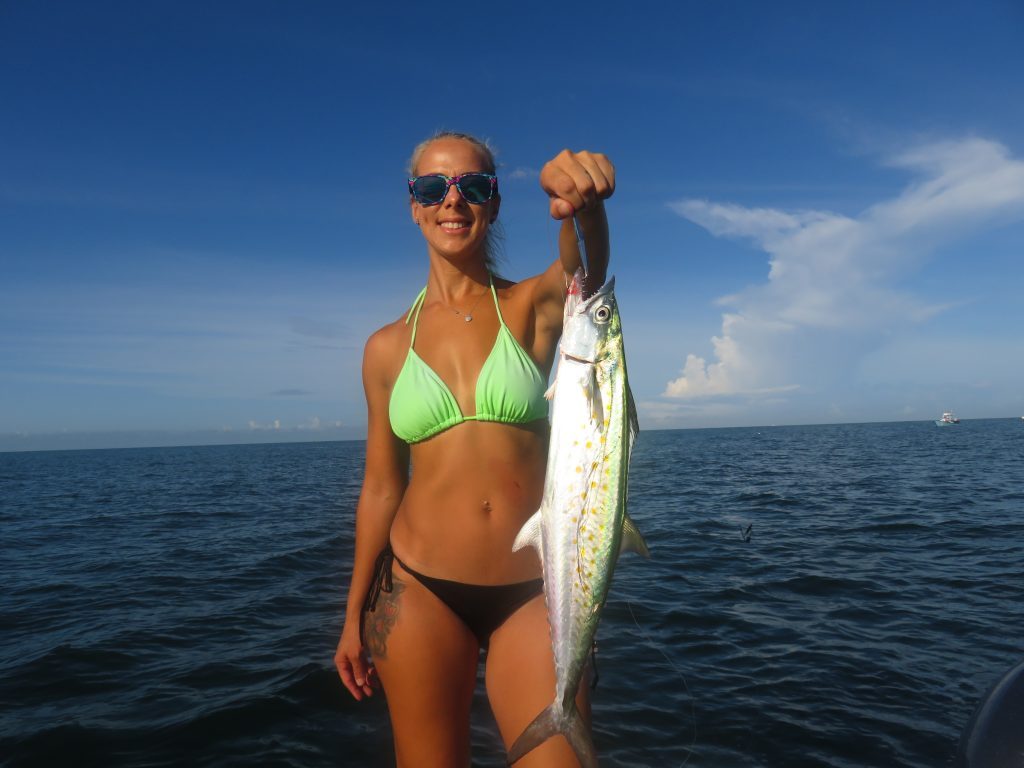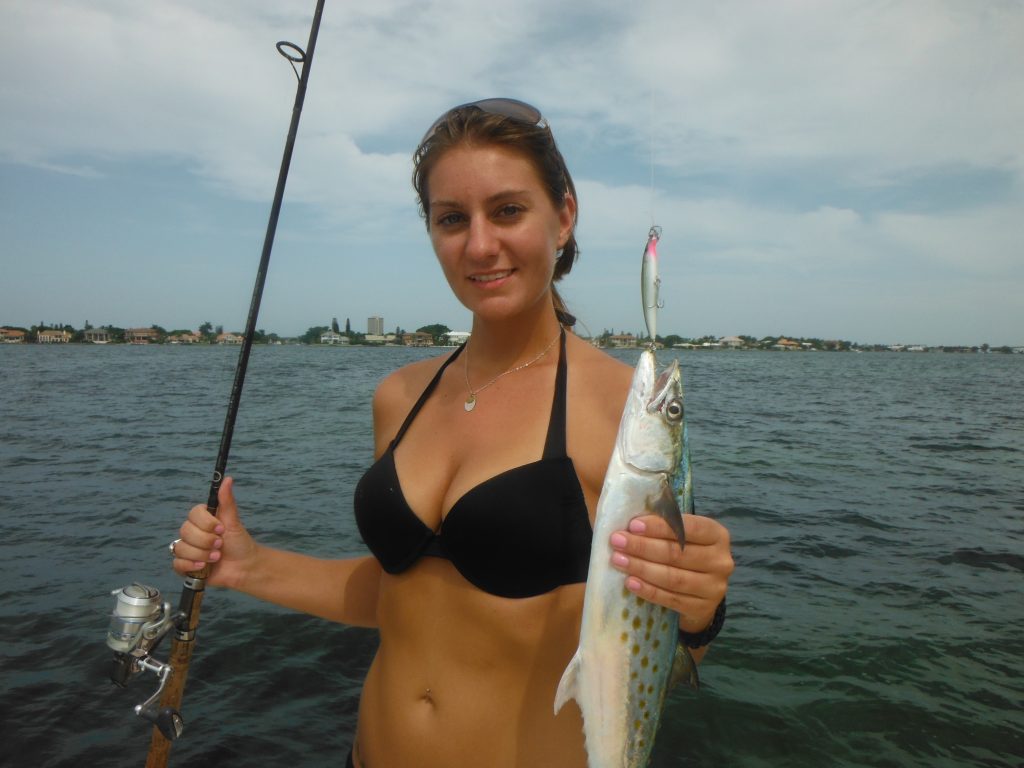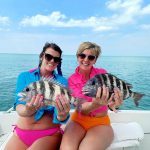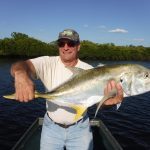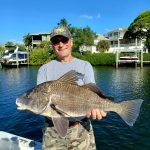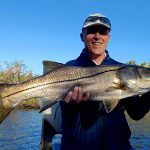Top 6 Spanish mackerel fishing lures
This post will list Capt Jim’s Top 6 Spanish mackerel fishing lures. Capt Jim has been running Sarasota fishing charters since 1991. He loves chasing Spanish mackerel and considers them an underrated game fish. They fight hard, attack lures and flies with reckless abandon, are beautiful, and are excellent table fare when prepared fresh. Spanish mackerel are found all along the Atlantic and Gulf coasts.
Capt Jim’s best 6 Spanish mackerel fishing lures are:
-
#8 Rapala X-Rap
-
Crocodile casting spoon
-
Clark trolling spoon
-
Bass Assassin Sea Shad baits
-
Gotcha lures
-
Diamond jigs
Spanish mackerel are aggressive feeders. They feed in clear water and use their razor sharp teeth to kill or wound prey. Then, they come back through and clean up the scraps. This makes flashy, fast moving lures the best choice when pursuing Spanish mackerel. Anglers can read more about Spanish mackerel fishing in this link.
Spanish mackerel fishing tackle
The best choice for most anglers fishing for Spanish mackerel is a 61/2 foot to 7 foot spinning outfit. Often times fairly long casts are required. 10lb monofilament or braided line works well. The good news is that most anglers who fish inshore salt waters throughout the country already own suitable equipment. Capt Jim likes the Daiwa Black Gold reel and St Croix Triumph rod combo.
Anglers can shop at Amazon for a Daiwa Black Gold reel and St Croix Triumph 7′ MF rod spinning combo in this link.
Light conventional tackle is better suited for anglers who like to troll for Spanish mackerel. Conventional tackle handles the strain of planers and larger plugs. Anglers can spool these outfits up with 30 lb monofilament or braided line. This outfit is also ideal for bottom fishing for other species as well as vertical jigging. The Squall 30 is an excellent and affordable light conventional outfit.
Anglers can shop Amazon for Squall conventional combos in this link.
“Fishing Lido Key is a participant in the Amazon Services LLC Associates Program, an affiliate advertising program designed to provide a means for sites to earn advertising fees by advertising and linking to Amazon. As an Amazon Associate I earn from qualifying purchases.”
Leaders of some type are required for Spanish mackerel fishing. Capt Jim uses a flourocarbon leader between 30lb and 50 lb test, depending on fish size and water clarity. Spanish mackerel will cut off lures, it is just part of the game. Steel leaders are an option. However, Capt Jim would rather get more bites and lose a few baits. In clear water, steel leaders will usually result in fewer strikes.
1) #8 Rapala X-Rap Slashbait
The #8 Rapala X-Rap Slashbait is number one on Capt Jim’s list of top Spanish mackerel fishing lures. It is his “go to” bait! Often times, Spanish mackerel are feeding on smaller sardines, herring, and glass minnows. These plugs closely mimic this small forage. White is the top color, with olive being second. Anglers should match the color to the water color and local forage.
These lures are extremely effective when both cast and trolled. Anglers can blind cast using a fast, erratic, aggressive retrieve. Also, they can be cast into feeding fish. This is great sport! Rapala X-Raps are also very productive when trolled. This can be done simply on spinning tackle. Anglers need only let out the plug, count to ten, and drive around. This is an excellent technique in shallow, inshore waters to locate fish. Also, they work well when trolled behind planers.
Anglers can shop Amazon for Rapala X-Rap fishing lures in this link.
2) Casting Spoon
The Crocodile casting spoon is a terrific lure! It is number two on Capt Jim’s list of top Spanish mackerel fishing lures. One ounce is a great all-round size, though anglers can go up in weight if needed. These lures cast a mile and are a great choice when mackerel are popping up quickly. Crocodile spoons wobble enticingly and put out a lot of vibration. They are also effective for blind casting. Trolling is also extremely effective. Anglers should use a swivel to prevent line twist when using spoons.
Anglers can shop Amazon for Crocodile spoon fishing lures in this link.
3) Clark Trolling Spoons
Clark trolling spoons are extremely effective when fishing for Spanish mackerel. They are long and slender and have a tight wiggle. Clark spoons can be trolled at fast speeds, up to 10 knots. They are very light, however, and it is not really an option to cast them. Clark spoons come in many different sizes to match the local forage. Some type of device is used to get the spoons down in the water column. Trolling weights and planers are most often used. Anglers can learn more about light tackle trolling in the linked article.
Check out the best inshore saltwater fishing tackle
Planers are clever devices that take a lure down, then “trip” when a fish is hooked. A #1 planer with a 20 foot long 40 pound test flourocarbon leader works great with a Clark spoon. This will dive down five to seven feet. Once the planer hits the rod tip, the fish will need to be hand lined in the rest of the way. Same goes for trolling sinkers. Generally speaking, the longer the leader, the more action the spoon will have.
Anglers can shop Amazon for Clark spoons fishing in this link.
4) Bass Assassin Sea Shad Baits
Bass Assassin Sea Shad baits are number 4 on the list of top Spanish mackerel fishing lures. These soft plastic baits catch just about every saltwater species, and Spanish mackerel are no exception. Anglers blind casting while drifting flats and passes catch mackerel when fishing for other species. They also work well when casting into schools of bait as well as breaking fish.
These baits are very economical to use. Spanish mackerel will tear up the grub. However, unlike a buck tail jig, the tail is easily replaced. Even if the entire jig gets cut off, the angler is out less than a dollar. It is hard to beat that these days! 4″ is the best size. Bass Assassin baits come in many different colors. All of them can be productive, with glow/chartreuse being Capt Jim’s favorite, followed by red/gold shiner. 1/4 ounce to 1/2 ounce jig heads are most often used, though anglers can go larger if depth or current dictates it.
Anglers can shop Amazon for Bass Assassin fishing lures in this link.
5) Gotcha lure
The Gotcha lure is a well-known and productive lure for catching Spanish mackerel. This is particularly true on the east coast. Surf and pier anglers use them extensively. They cast a mile, have a lot of flash, and the hook-up rate is excellent with the treble hooks. They are also reasonably affordable. The best Gotcha lures for mackerel have the chrome finish.
The Gotcha lure is very easy to use. It is cast out, allowed to sink, then brought back in as fast as possible with hard, aggressive jerks. The bait will flash and roll and attract Spanish mackerel to it. obviously, it works great when cast into breaking fish. This lure is primarily designed to catch Spanish mackerel, and it does the job well!
Anglers can shop Amazon for Gotcha fishing lures in this link.
6) Diamond jigs
Diamond jigs are a bit of a ‘secret weapon” among charter boat captains in my part of the world. They do not look like much, nor do they have a lot of action. However, they are extremely effective in a certain application. That is when Spanish mackerel are feeding on glass minnows in clear water. They can be extremely fussy then and can be difficult to fool. The Diamond jig has just enough flash to get them to bite. They are light, therefore most often trolled as opposed to being cast out. One ounce works well when the bait is small. Larger versions are often used by anglers vertically jigging over structure.
Anglers can shop Amazon for Diamond jigs in this link.
Spanish mackerel fishing tips!
Spanish mackerel fishing in Florida is enjoyed by many anglers. They are a terrific game fish that is widely distributed throughout the state. Spanish mackerel are available in all of the inshore and coastal waters of Florida at one time of the year or another. Spring and fall are top times to fish for them. Spanish mackerel are a hard fighting a great tasting species that put up a terrific fight on light tackle.
The Atlantic Spanish mackerel is a migratory species that is found throughout the entire Gulf of Mexico. They also migrate as far north as Cape Cod. Spanish mackerel are a schooling fish that prefer relatively shallow water. While opportunistic feeders, their primary forage is small bait fish. This makes them prime candidates for anglers who prefer to cast artificial lures and flies in pursuit of them.
Spanish mackerel fishing tackle
The tackle used by anglers fishing for Spanish mackerel in Florida is fairly basic. The same inshore tackle used for speckled trout, snook, redfish, and other species will do fine when chasing mackerel. A 7 foot medium light rod with a fast action paired with a 3000 series spinning reel is an excellent combination.
Anglers can opt for 10 pound monofilament or braided line, depending on preference. In this application, monofilament line is often preferred due to its stretch. Spanish mackerel hit so hard that often times the stretch and the line helps prevent the hook from pulling. Also, Spanish mackerel are most often encountered in open water where obstructions and structure are not an issue.
Rigging up for Spanish mackerel
The first thing most anglers notice when landing a Spanish mackerel is a mouthful of sharp teeth! Some type of leader is definitely required when fishing for Spanish mackerel. These teeth result in anglers making a choice when it comes to rigging; monofilament or wire leader. Spanish mackerel are most often found in clear water. The use of wire leaders in clear water will often result in fewer strikes.
Anglers may choose to use 30 pound to 40 pound fluorocarbon leader’s instead. This will certainly result in more lures and hooks being cut off. However, the trade-off will usually be more strikes. It is a compromise a decision that anglers will have to make. It does get frustrating, and expensive, when a bunch of lures are lost to these toothy critters.
Fishing for Spanish mackerel with lures
Spanish mackerel are a species that are perfect for anglers who prefer fishing with artificial lures. Mackerel are very fast and often times charge into a school of bait fish with the intention of injuring them with their sharp teeth. They then go back through the wounded bait fish and pick off the stragglers and scraps.
The most productive lures for anglers Spanish mackerel fishing have two characteristics; a fast erratic action as well as some flash. Silver spoons, Gotcha lures, diamond jigs, plugs, and jigs are all top artificial lures. All of these baits imitate wounded bait fish, which is the primary forage of Spanish mackerel. The ability for these lures to be cast a reasonable distance is one more advantage.
Spanish mackerel fishing techniques
Spanish mackerel fishing can be very visual. This is one of the elements that attracts anglers to pursuing these fast and feisty game fish. Mackerel are very often seen foraging violently on the surface. When the water is calm, the churned up surface can be seen from quite a distance away. Actively diving and feeding birds are another sign that Spanish mackerel may be in the vicinity.
When mackerel are feeding on the surface in this situation, there usually very easy to catch. Just about any shiny lure that is cast into the fray will draw a strike. Silver spoons and Gotcha lures are excellent for this as a can be cast a long distance. This is particularly true for anglers fishing without a boat. Plugs and jigs will also catch plenty of mackerel in this situation.
Anglers fishing in boats have the advantage of being able to chase down schools of feeding mackerel. Spanish mackerel do tend to stay on the surface longer than some other species such as false albacore. The best approach is to intercept the school of feeding fish, positioning the boat ahead of and upwind of the school. This is a result in an easy down when cast into the fish.
Spanish mackerel fishing inshore
Spanish mackerel will also invade the inshore waters of Florida as well. Inlets, passes, and flats produce a lot a fish. Mackerel are less often seen feeding on the surface in these inshore waters than they are in the open waters of the Ocean and Gulf of Mexico.
Drifting is an excellent method used by anglers to locate schools of Spanish mackerel in the inshore waters. This is done both in the passes and inlets as well is on the flats. Deeper grass flats, those in 6 feet of water to 10 feet of water, and closer to the inlets and passes are often the best flats in which to locate Spanish mackerel. Inlets and passes will hold a lot of fish, particularly when bait is present.
Anglers drifting for Spanish mackerel can choose to fish with both live and artificial baits. A live shrimp or bait fish free lined out behind the boat works very well. A split shot or two can be added to get the bait down in the water column if required. A long shank hook will help reduce cutoffs. 1/0 is a good all-around size.
Artificial lures can certainly be used when drifting the grass flats as well. Spoons, plugs, and jigs all work well when fan cast out in front of a drifting boat. Spanish mackerel are attracted to fast-moving flashy lures. Therefore, and aggressive, erratic retrieve often works best. Spanish mackerel are often found in the upper part of the water column, so lures that work a few feet below the surface are often the most productive.
Mackerel fishing in the Gulf of Mexico and Atlantic Ocean
Many anglers Spanish mackerel fishing in Florida do so in the open waters of the Atlantic Ocean and Gulf of Mexico. These game fish are often found in large numbers in shallow water quite close to shore. This makes them excellent opportunities for shore bound anglers as well as those fishing and smaller boats. Mackerel can be caught in these waters sight fishing, drifting, structure fishing, and trolling.
Surface action is great fun!
As mentioned earlier, searching for schools of Spanish mackerel actively feeding on the surface is great sport! Anglers in boats often times cruise the coast several hundred yards off shore in search of feeding fish. On a call day, this action is easily seen as the surface of the water will be literally boiling. Diving birds will also give away the location of foraging schools of Spanish mackerel.
This is a situation that is tailor-made for anglers fishing with artificial lures. The fish are already located in actively feeding. Therefore, just about any fast-moving and flashy lore cast into the fray will draw a strike. Anglers who prefer to use live bait can certainly cast a hook baited with a shrimp or bait fish into the mix.
Drift fishing in open water
Anglers can choose to drift in the open waters of the Atlantic Ocean and Gulf of Mexico. However, it is often times less effective than it is in the inshore waters due to the area that needs to be covered. Drifting works best when done over areas of hard bottom as well as wrecks and artificial reefs. It is also productive when mackerel are not working on the surface but are known to be in a certain area.
Structure fishing for Spanish mackerel
Like just about every other saltwater game fish, Spanish mackerel are attracted to structure. The primary reason for this is that structure attracts bait fish. This in turn attracts game fish species such as Spanish mackerel along with king mackerel, false albacore, and other inshore species.
Structure can take the form of artificial reefs, wrecks, hard bottom ledges, piers, bridges, and even channel markers. Wrecks, artificial reefs, and natural hard bottom ledges are the prime spots for anglers Spanish mackerel fishing in Florida in the open waters. Anglers can choose to anchor up current of the structure and chum, then drift back live and cut baits to the fish. This is the best approach on smaller pieces of structure. Trolling and drifting can also be productive, especially over larger wrecks and reefs.
Trolling for Spanish mackerel
Trolling is an excellent technique used to catch Spanish mackerel. It is basically the act of pulling lures behind the boat in search of fish. As mentioned several times, Spanish mackerel prefer a fast-moving and flashy baits. Trolling spoons are specifically designed to be trolled at fast speeds, between 5 kn and 7 kn. This allows anglers to cover a lot of water in search of fish. It is an excellent tactic when Spanish mackerel are not seen working on the surface or when that action is sporadic.
Techniques for trolling
Trolling requires at the lures get down in the water column. There are several different methods that can be used to accomplish this. The easiest method is to use a plug. Plugs have lips on them which will determine the depth that which the plug will dive when being pulled behind the boat. Since mackerel feet near the surface, plugs that dive down between several feet and down to 7 feet or so work best. Trolling with plugs requires no extra special gear, the plug is simply tied onto the end of the leader.
Spoons do require some type of device to get them down in the water column. Otherwise, when trolled at a fairly brisk pace they will simply rise to the surface and skip about. The two devices used to get spoons down in the water column are planers and sinkers. Both methods are a bit cumbersome and require longer leaders. However, the effort is worth it and will result in a lot a fish being caught.
Using trolling sinkers to catch Spanish mackerel
Trolling sinkers are fairly easy to use, they come in several different designs with the torpedo shaped being the most common. They also come in several weights which will allow the angler to adapt to the conditions in depth being fished. The trolling sinker is simply tied onto the end of the running line. Then, a 10 foot to 20 foot long leader is used between the trolling sinker and a spoon.
Both light conventional tackle and spinning outfits are fine when using trolling sinkers. The same inshore spinning tackle will work well when using lighter sinkers for average sized Spanish mackerel. Light conventional tackle is a better choice when using heavier weights for larger Spanish mackerel or when king mackerel are around.
Deploying this rig is very easy, with the boat in gear and at idle speed the spoon is tossed out and then the trolling sinker is lowered into the water. Line is then let out behind the boat. Counting out 10 or 15 seconds is a good place to start. Rod is then put in a rod holder in the boat is driven around in search of fish.
There is no doubt when a strike occurs! The rod tip will start throbbing and a larger fish drag will be heard screaming from the reel. The fish is then played back to the boat. Once the trolling sinker reaches the rod tip, the angler can real no further. The fish must be then hand lined in the rest of the way. Plugs and other lures can also be used behind trolling sinkers.
Using planers to troll
A planer is a clever, though slightly complicated, device that allows anglers to get lures down in the water column. They work similar to diving plugs in that they have a flat surface that digs down into the water when pulled behind the boat. However, they have a sliding ring which allows the planer to “trip” when a fish strikes. This allows the angler to fight the fish without the drag of the planer.
Planers come in sizes. A number one planer will dive down 5 to 7 feet and a number two planer will dive down 12 to 15 feet. These are the two most commonly used planers by anglers fishing the inshore waters. While spinning tackle can be used, light conventional outfits are a better choice in most instances.
As with trolling sinkers, long leaders are required between the planer and the spoon. 20 feet is a good all-around length. Generally speaking, the longer the leader the better the action the spoon will have. Also as with trolling sinkers, once the plane reaches the rod tip, the fish will have to be hand lined in the rest of the way.
Deploying the planer takes a bit of practice it first. The spoon is tossed in the water as the boat is idled along. The planer is then lowered into the water with the split ring at the top. This will result in the planer digging down into the water. Line is then fed back, the real put in gear, and the rod placed in a holder. There will be a noticeable bend in the rod due to the drag of the planer. When a fish hits, the planer will trip and the rod tip will start bouncing.
Spanish mackerel on the dinner plate
Spanish mackerel often get a bad rap when it comes to table fare. In fact, many anglers consider them one of the best eating fish and saltwater. However, they do need to be handled carefully. Spanish mackerel are plentiful in omega three oils, which makes them a good fish to eat. Fish that are to be For dinner should be iced down immediately and eaten that they were the next. They do not keep or freeze well.
Spanish mackerel can be baked, broiled, grilled, poached, or even boiled. Yes that’s right, boiled! Due to their oily nature, angler should avoid frying them. In most cases, the skin can be left on when preparing them.
GRILLED
Most Spanish mackerel caught by local anglers and up on the grill. Mackerel are a perfect fish for the grill as a are naturally oily and will not dry out like other species. The skin is usually left onto keep the fillets intact. The fillets are laid skin side down on a grill pan or even on the rack and season to taste. 6 to 8 minutes and a hot grill will usually get it done.
BAKED
Spanish mackerel very well in baked and this is an easy preparation. The fillets are laid skin side down on a baking sheet and then covered with a tire breadcrumbs. Lemon slices can be added if desired. The fishes then baked in a hot oven, 450° works well. Depending on the thickness of the fillets, it will take 6 to 10 minutes for them to be done.
BROILED
Broiled Spanish mackerel is delicious and is also a very easy way to prepare them. The fillets are laid skin side down on an oiled pan and then seasoned to taste. Salt and pepper works fine as does just about any other seasoning mix, either custom or commercially prepared. Again, 6 to 10 minutes under a hot broiler should be fine.
POACHED
Poaching is another easy and simple method to prepare Spanish mackerel. One method that works very well is to heat up spaghetti sauce in a skillet and then poach Spanish mackerel fillets in the sauce. The skin is usually left onto keep the fillets from falling apart. The fish absorbs some of the tomato flavor and the tomato sauce absorbs some of the fish flavor. This can be served with a little side of pasta and is an excellent meal!
In conclusion, this post on the top 6 Spanish mackerel fishing lures will help anglers catch more of these speedy game fish!
